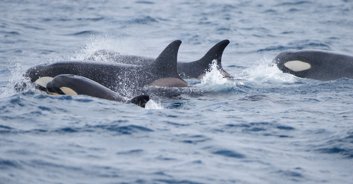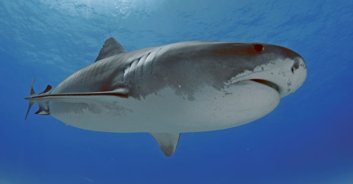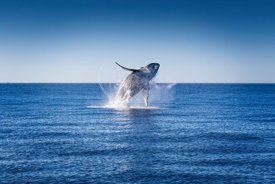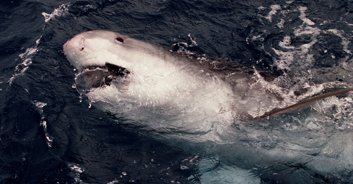Warfare isn’t what it used to be. Gone are the days of two armies doing battle on some destitute, grassy plane hundreds of miles from civilisation. Today, warfare is about technology, infrastructure, stockpiling and espionage. However, we may be missing one crucial ingredient - a tame, 3,000-pound sea mammal.
“We were going to put out nets when we saw a whale swimming between the boats,” fisherman Joar Hesten told Norwegian broadcaster NRK. “It came over to us, and as it approached, we saw that it had some sort of harness on it.”
Norweigan marine experts believe the creature could be a part of some kind of Russian navy special ops force. The whale was friendly and, despite its large brain, perhaps failed to differentiate between Norweigan fishermen and its supposedly Slavic superiors.
The whale was said to be acting strangely, seeking out and pulling straps and ropes on the side of the boats. Inside the harness was the message “Equipment of St. Petersburg”. While this seems almost too perfect a clue, some speculators believe this adds further weight to the argument that Russia was behind it.
“We know that in Russia they have had domestic whales in captivity and also that some of these have apparently been released,” explained Audun Rikardsen, professor at the department of arctic and marine biology at the Arctic University of Norway. “Then they often seek out boats.” Having contacted Russian researchers he believed would be able to shed light on the situation, he was told they had nothing to do with it. “They tell me that most likely [it] is the Russian navy in Murmansk,” said Rikardsen.
“If this whale comes from Russia - and there is great reason to believe it - then it is not Russian scientists, but rather the navy that has done this,” said Martin Biuw of the Institute of Marine Research in Norway. Furthermore, the Russian military has form when it comes to these kinds of sea life shenanigans.
In the 1980s, they devised a programme whereby they recruited dolphins for military training. Known for their intelligence, they proved to be good at remembering instructions and detecting weapons. The programme was discontinued in the 1990s however, three former Soviet military bases have recently opened up along Russia’s Arctic coastline. In fact, a 2017 report by TV Zvezda, a station owned by the Russian defence ministry, explained that they had begun training seals, bottlenose dolphins and, crucially, beluga whales.
Acting on behalf of the Russian navy, researchers from Murmansk Sea Biology Research Institute recently tested whether beluga whales could “guard entrances to naval bases’” as well as “assist deepwater divers and if necessary kill any strangers who enter their territory”.
Meanwhile, dolphins and seals were trained to carry tools for divers and detect mines and torpedoes at depths of more than 100 metres. Looking at government public records, it is possible to see that five bottle-nosed dolphins were purchased from Moscow’s Utrish Dolphinarium in 2016 by the government. The going rate in 2016 for five Russian dolphins? $23,500.
The research concluded that the arctic waters in which the programme was running were too cold for the beluga dolphins and that the seals, out of the three types of marine mammal, were the best at following commands and showed “high professionalism”.
However, Russia’s military isn’t the only one making friends with sea life. Just last month, it was reported that the US navy’s Persistent Aquatic Living Sensors (PALS) programme was exploring ways of using fish and other marine animals as spies.
“The US Navy’s current approach to detecting and monitoring underwater vehicles is hardware-centric and resource intensive,” said programme manager Dr Lori Adornato. “As a result, the capability is mostly used at the tactical level to protect high-value assets like aircraft carriers, and less so at the broader strategic level.”

The PALS programme launched last year and follows this strangely common trend of exploiting animals’ superior abilities in certain fields. “If we can tap into the innate sensing capabilities of living organisms that are ubiquitous in the oceans,” Dr Adornato adds, “we can extend our ability to track adversary activity and do so discreetly, on a persistent basis, and with enough precision to characterise the size and type of adversary vehicles.”
Almost $50 million has been distributed across five teams, with special attention being paid to how signals are sent, received or accidentally broadcast under water. Not all the creatures are large, however. One being studied is the snapping shrimp, which emits 200-decibel “pops” which could be employed as an organic form of sonar. “It has the potential to detect even the quietest vehicles that might be there,” project leader Dr Alison Laferriere of Raytheon BBN Technologies told Scientific American.
PALS also ran a separate initiative, dubbed Insect Allies, which aimed to genetically change crops by loading synthetic viruses onto insects. However, it received widespread criticism from the scientific community after fears it could lead to “a new class of biological weapon”.

There are also concerns over the animals’ safety. After all, no matter how much PR-proofing is applied, they are still a means to an end. However, in the case of the beluga whale, the harness was removed and not reattached.
Nonetheless, these military animal initiatives look to be here to stay. The noughties kids’ classic Cats and Dogs - which sees household pets become masters of weaponry and espionage - is no longer seeming quite so ridiculous. Bizarre in the extreme, this concept of weaponised animals has skipped sci-fi and landed directly in real life.
Video credit: Jørgen Ree Wiig





